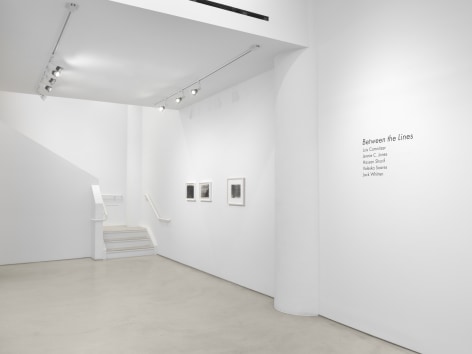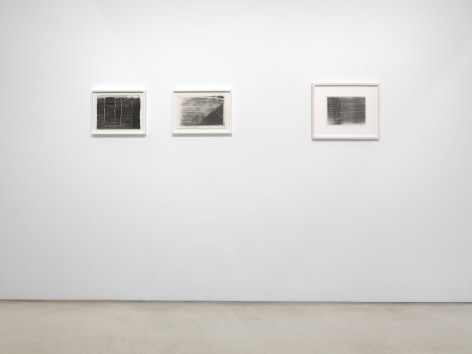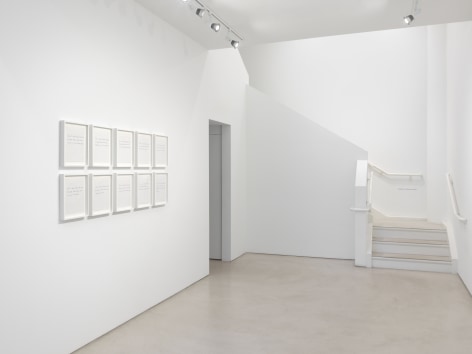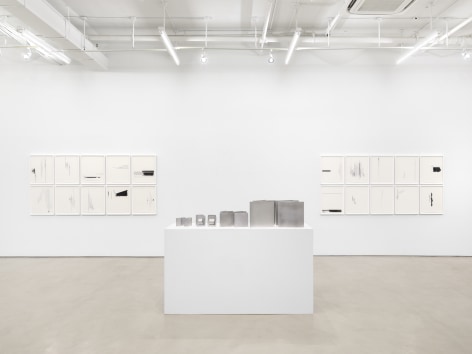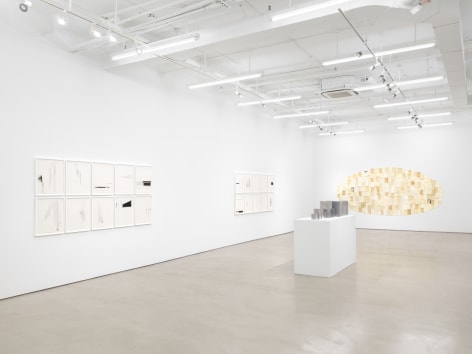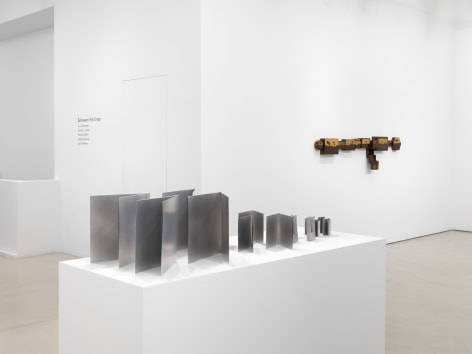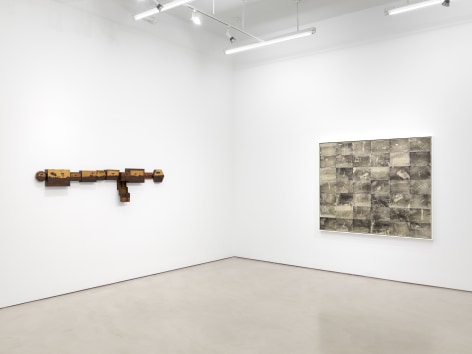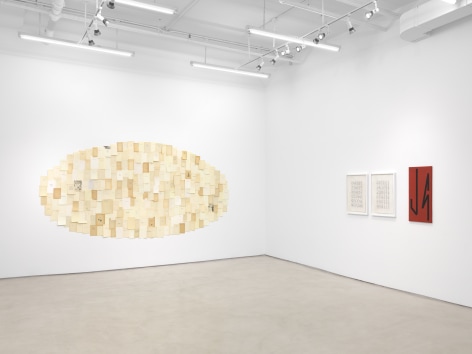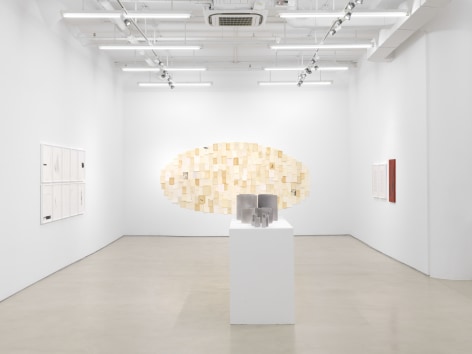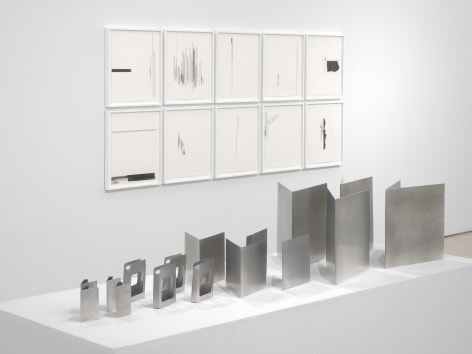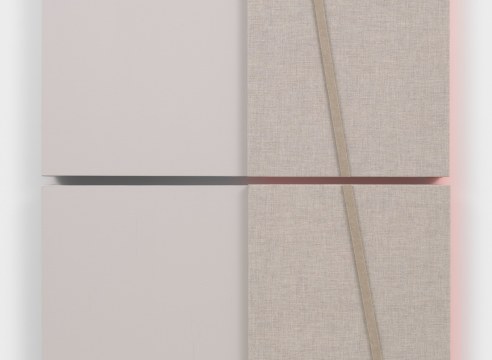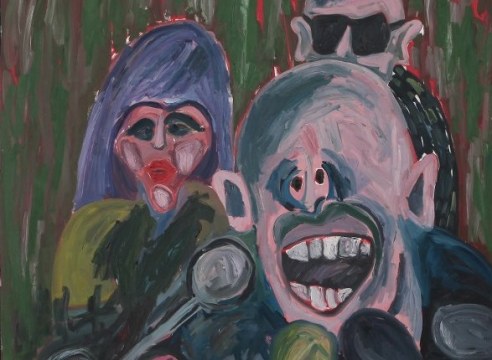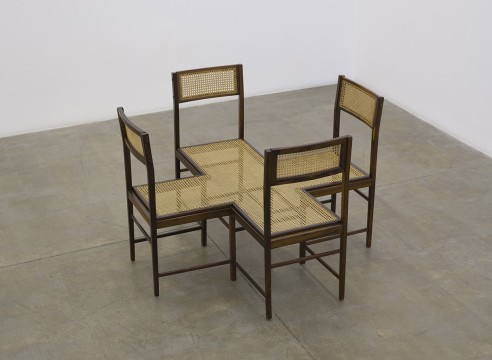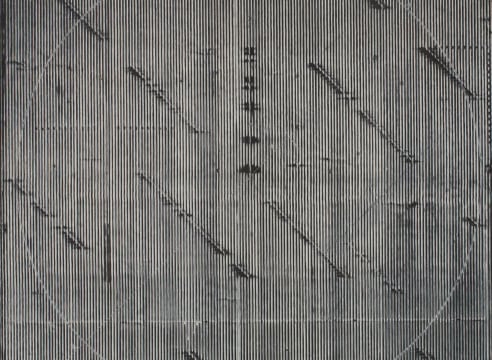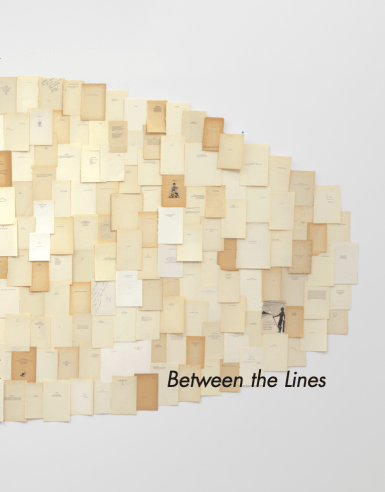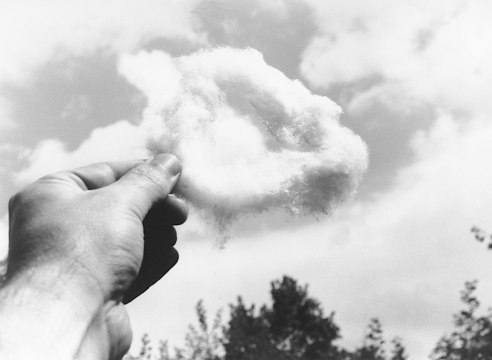
Alexander Gray Associates, New York presented Between the Lines, a group exhibition of recent and historic sculptures and works on paper by Luis Camnitzer, Jennie C. Jones, Hassan Sharif, Valeska Soares, and Jack Whitten. Borrowing its title from a 2013 piece by Camnitzer, the show juxtaposes each artist’s distinct visual approach while underscoring the conceptual rigor and seriality that unites their disparate practices.
Jennie C. Jones anchors the presentation with two 2016 groupings of drawings from her ongoing series Score for Sustained Blackness. Much like Jones’ celebrated Acoustic Panel Paintings, which integrate musical structures into their compositions, this series incorporates gesture into musical notation. Recalling expanded understandings of music that were advanced by Fluxus artists and composers like John Cage, the works deconstruct a musical staff. Transforming wild mark-making into booming crescendo, through repetition they establish a connection between drawing and the sonic. Shown in conjunction with Song Containers (2011), elegantly spare aluminum sculptures that replicate the packaging of analog playback technologies, Jones seamlessly integrates the formal with the aural to create a new abstract language.
Just as the hollow forms of Jones’ Song Containers allude to silence—what can no longer be listened to—so too do the empty boxes of Valeska Soares’ Palimpsest I (2016) suggest what is obscured—what can no longer be seen. Recontextualizing a series of Brazilian boxes with wooden marquetry tops that depict landscapes, the installation subsumes the makers of the boxes and the objects they might have once held in favor of producing a grand vista. Staining the boxes’ lids and carefully installing them so that they share a horizon line, Soares crafts a mysterious panoramic nightscape whose individual trees and hills are effaced to emphasize a new collective narrative based on a tropical idyll. Also imbuing mundane items with an evocative artistic charge, Soares’ For To (X) (2017) repetitively layers dedication pages torn from antique books into a tight oval on the wall. Exploring concepts of ephemerality and nostalgia, the formally austere work highlights the lives of authors and gift-givers, inviting viewers to read between the lines to construct past personal histories though messages of love and thanks.
Displaying a similarly inventive use of materials, Jack Whitten’s groundbreaking 1974 Xerox Project monoprints experiment with toner as a medium. Carefully applied to rice paper, this powder allowed him to achieve a range of spontaneous effects—from deeply saturated volumes to delicate, streaky lines of pigment—while interrogating gesture and form. At once suggesting topographical mapping and satellite photography of the moon, these prints recall the artist’s time spent as a cadet at Tuskegee University. Works like Xeroxed! (1975) forward a process-driven approach to seriality by presenting multiple toner monotypes arranged in a grid and mounted on canvas. Eroding distinctions between drawing and painting, the piece marries gesture with technical experimentation. Ultimately establishing Whitten’s artistic framework, his Xerox monoprints paved the way for the aesthetic innovation of later series like the artist’s celebrated Greek Alphabet paintings.
Like Whitten, who sought to develop a more conceptual approach to painting, Hassan Sharif also invented alternative, cerebral ways to draft an image. Beginning in the 1980s, he coined the term “semi-system” to describe his compositional techniques, which were based on invented calculations and seemingly endless repetitive permutations. Sharif’s Semi-Systems like Seven Points Angular Lines - Part 2 (2013) both follow and challenge the logic of these self-imposed rules. Presenting viewers with a system that is constantly on the verge of breaking down, the work’s agitated, pseudo-calligraphic strokes echo the frenetic development that occurred in the United Arab Emirates as it became a global economic hub.
In contrast to Sharif’s quasi-mathematical formalism, Luis Camnitzer uses language, itself, as a medium. His ten-part work, Between the Lines (2013), presents viewers with variations of the same sentence inscribed on lined paper. Beginning with the phrase “When I read between the lines the paper stares back at me …,” each iteration constructs its own poetics around the creative process while forwarding an expansive understanding of that process based on the repetitive potential of constant revision.
Although Camnitzer ultimately concludes his 2013 artwork by writing, “When I read between the lines the paper stares back at me telling that I haven’t wondered enough,” the artists in the Gallery’s exhibition are always wondering—challenging and expanding upon established methodologies. Relentless innovators, they read between the lines of a musical staff, audio recording packaging, the horizon, books, toner, an algorithm, and a page to redefine approaches to art-making.

